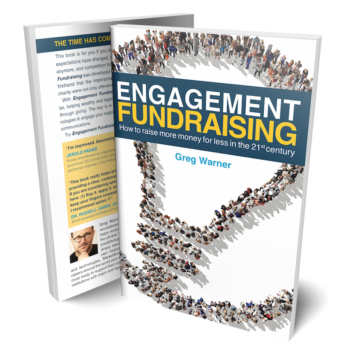We use cookies to ensure that we give you the best experience on our website. By continuing to use this site, you agree to our use of cookies in accordance with our Privacy Policy.
 Login
Login
Your Role
Challenges You Face
results
Learn
Resources
Company
6 Ways to Reframe or Lower the Costs of Giving a Major Gift


Like any other donors, wealthy donors want to give. But when wealthy donors give, it’s usually a major gift, meaning it’s a big number. And even though the wealthy person can ‘afford’ to make that gift, they are still human. That means they feel the cost of giving away such a large amount of money, just like anyone else would.
All donations happen at the “intersection of motivation and cost,” as renowned researcher Dr. Russell James puts it in our Donor Story: Epic Fundraising eCourse. They want to give. That’s motivation. But they are uncertain of how much they should give. That’s cost.
For an average person, giving away $1000 to a charity might feel like a big decision. Sure, if you’re making $80,000 per year, you can afford that gift. But you still feel the cost, because you get nothing in return. Likewise, a wealthy person who might have $10 million to their name will still feel the cost of giving a $50,000 gift. Yes, they can afford it, but it’s still a lot of money to just hand over.
To help such donors feel more confident that they are making a great decision, and to help them follow through with their gift and not regret it later, gift officers need to reframe the costs of giving.
Giving the same gift can be made to feel very different, depending on how you structure and talk about the gift.
Here are six ways to reframe or lower the costs of making a major gift, for your wealthy donors.
1. Number Sequencing
Giving is partly about math, because giving involves numbers. But as Dr. James’ research reveals, focusing on math too much inhibits fundraising. People give less when you bombard them with numbers. And they give more when you focus on story first, and then bring in the numbers second.
That’s the sequence – arouse motivation to give to such a degree that when you get to the numbers, the donor isn’t dissuaded because they’ve already made up their mind.
The story you focus on can come from several places. It could be the donor’s life story. In fact, you should always start here.
Help the donor connect their own life story with the act of giving to your nonprofit. What impact do they want to have? How do they want to be remembered? What do they want their kids to say about them? What story do they want told about their life?
That’s big stuff. Don’t neglect it, and don’t minimize it.
Emphasize it. Lead with it.
In addition, you can also bring in stories of impact from your organization. What will their gift accomplish? Who will benefit?
The best way to do this is to pick one or just a handful of characters and share their stories. Don’t talk about helping 1000 starving kids. Talk about one kid and the difference it will make to provide food and other basic needs for that kid.
Then, once the donor has decided to give, you can bring in the numbers. What numbers?
It depends on the specifics. But those numbers could be tax deduction opportunities that reduce the cost of giving. Other numbers might be using a Donor Advised Fund, a trust, or a gift from an estate.
There is a magic phrase you’re looking for before getting too far into the numbers:
“I wish I could do more, but…”
That’s the golden parachute. That means you have aroused this donor’s motivation to give and taken it to the max. They are primed to donate. They want to give. They are now at the crossroads of motivation and cost.
So now is when you want to help them defray the cost by introducing other ways to give, and ways to reduce the cost of giving.
2. Number Socializing
Another way to describe this strategy is ‘humanizing money.’ Turn money into something other than what it is, and you can lower the hurdle of parting with it.
Dr. James reports research from the 2019 Journal of Consumer Research where nonprofits used a cartoonish version of a dollar bill, or money with eyes and arms and legs. When they used these, donations doubled.
Why? Because it turned money into a character in the story, rather than a cost to part with.
Obviously you can’t just keep pulling out that same trick, but it illustrates the strategy of altering the perception toward what is being donated.
Another experiment from the 2018 Journal studied a corporation that was doing cause marketing. They compared a campaign promising to give $1 million to a charity with giving $1 million worth of medical supplies. When surveyed, people rated the company as far more generous and helpful for giving the medical supplies – even though the actual value of the gift was identical.
The point is, objects reflect greater kindness than cash, because objects make us think of people being helped in specific situations. Whereas cash is just money that goes…somewhere.
How can you use this with major donors?
Accepting donations of land, homes, commercial real estate, and even artwork can be a powerful strategy. Yes, the donor could have written a check for the same amount of money, but with a more tangible gift, they feel like they have demonstrated greater kindness and generosity.
3. Number Comparing
Which feels more costly – giving $100,000 from a $5 million bank account, or giving $100,000 from a $20 million IRA?
That’s the idea behind number comparing. You want to enable the wealthy donor to see that their gift represents a small percentage of their overall net worth.
Most wealthy people have assets in all sorts of places in addition to traditional bank accounts. But the vast majority of their wealth is held in other assets like IRAs, trusts, business equity, real estate, stock options, and DAFs. So if you try to motivate a gift only from their traditional bank account, you are trying to pull from just one small piece of their overall portfolio.
Thus, they will likely resist giving as large a gift as they would if they gave from another much more valuable asset.
A big ask from a small category doesn’t work as well.
Suppose a wealthy donor wants to donate $10,000 in stock, but your executive director doesn’t want to hassle with that and prefers just taking a check for the same amount. What should you do?
Persuade your ED to take the stock. Why? Because the stock is likely pulling from a much larger pie. And that means, future gifts will likely be as large or larger. This is even more true considering that the capital gains tax deduction makes the gift of stock less costly to the donor.
4. Number Subtracting
A matching gift feels more heroic than a gift with a tax deduction. The match leads to more gifts from others and thus a larger impact. But the deduction feels like a more selfish motive. In other words, the deduction subtracts the cost of giving, but it doesn’t feel quite as good.
So, if no match opportunity is available (or even if there is), how can you reframe the tax deduction to make it seem like it has the same impact as a matching gift?
The answer:
Use language that presents the tax deduction as if it were a match.
Here’s what NOT to say:
“You give and you get a tax benefit in return. This means the charity benefits and so do you.”
This is a true statement, but you can see the benefits to the self in how that is phrased. Here’s what to say instead:
“You give and the government matches your gift with a tax benefit. Your dollars become more powerful because the government pays for part of the cost of the gift.”
See the difference? The gift is the same amount, and the tax benefit is the same. But this way of phrasing it repositions the gift as a match. The match in this case is just coming from the government rather than other individual donors.
5. Number Multiplying
Remember, most of these strategies don’t alter the amount of the gift. You’re just presenting it in a different way that makes it seem less costly, more effective, or both.
The act of giving is itself an emotional decision that affects the brain in positive ways. You feel good after giving. So, what if we could multiply the number of times a donor feels those feelings?
This is one reason why pledges are so powerful.
When the donor makes the pledge, they feel like they have already given. They feel good about what they have done, even though no money has changed hands. Later, when they fulfill the pledge, they experience those feelings a second time. So, one gift becomes two giving experiences.
The same dynamic happens at fundraising auctions. When someone donates an item to be auctioned, they feel good about that donation. Later, when someone else buys their item, the donor of the item feels like they have given again, even though this second time is the only time actual money changes hands.
With foundations, DAFs, and trusts, you can turn one gift into three giving experiences.
First, the donor gives to their own fund or trust. Second, they manage the assets, and as those assets grow, they feel good about their growing charitable impact. And third, when the donor finally transfers some of those funds to a nonprofit, they experience a third moment of generosity.
Again, only in the third step does actual money change hands. But because the experience of giving happens three times, donors feel much more generous about using these methods as opposed to just writing a check.
Weird, right? But true.
You can even apply multiplication to legacy giving that sometimes comes with convoluted instructions. Why do this when they could just write a check? Because to the donor, knowing that every month, or every year, their foundation or estate will be paying out $10,000 to their favorite nonprofit – yours, if you open yourself up to these approaches – feels like immortality.
Even after they have died, they will still be giving, impacting, and influencing. Thus, these instructions feel, to them, like giving forever. That’s taking multiplication to the max.
6. Number Dividing
Pledges actually help reframe the costs of giving in two ways. In addition to multiplying the giving experience, making a pledge feels like a smaller cost because you don’t actually give right away.
The donor feels all the motivations and feelings around giving, and makes the pledge, knowing full well they haven’t actually given the money yet. Later on, when the time comes to fulfill that pledge, the process feels more like paying a bill. It’s just something you said you would do and now you’re doing it.
Same amount of money, but the cost feels less weighty because the decision to pay it was made weeks or months in the past.
This is why you should deliver a very good thank you experience after a pledge is made – before the gift has been given. That makes it much harder to back out later, because it reinforces that their decision to give was a good one and has already made a huge impact.
Division is also another factor in why DAFs have such a broad appeal to donors. When you donate to your own charitable fund, that’s not as painful as a normal gift because you still control the investment, plus you get the tax benefit.
Later on when you decide to give, the cost feels less because some of the money you’re giving was ‘earned’ as part of your investment. So, giving $20,000 from a DAF feels much smaller to the donor than giving $20,000 from a checking account.
The Story of Major Gifts Fundraising
You will discover so much more about making the donor’s story central to major gifts fundraising when you take our groundbreaking eCourse, Donor Story: Epic Fundraising.
There is no other course like this anywhere, because all the other courses operate from the same set of foundational principles. But this one builds on a new foundation – helping the donor advance their own personal hero story, through giving to your specific nonprofit.
Start the course today, or join the waitlist for the next time it opens.
Related Resources
- Why you may need to reframe the donor’s hero story
- Donor Story: Epic Fundraising eCourse
- Why your greatest enemy in major gifts fundraising is the status quo
LIKE THIS POST? PLEASE SHARE IT! YOU CAN ALSO SIMPLY LEAVE YOUR THOUGHTS BELOW.
Get smarter with the SmartIdeas blog
Subscribe to our blog today and get actionable fundraising ideas delivered straight to your inbox!
